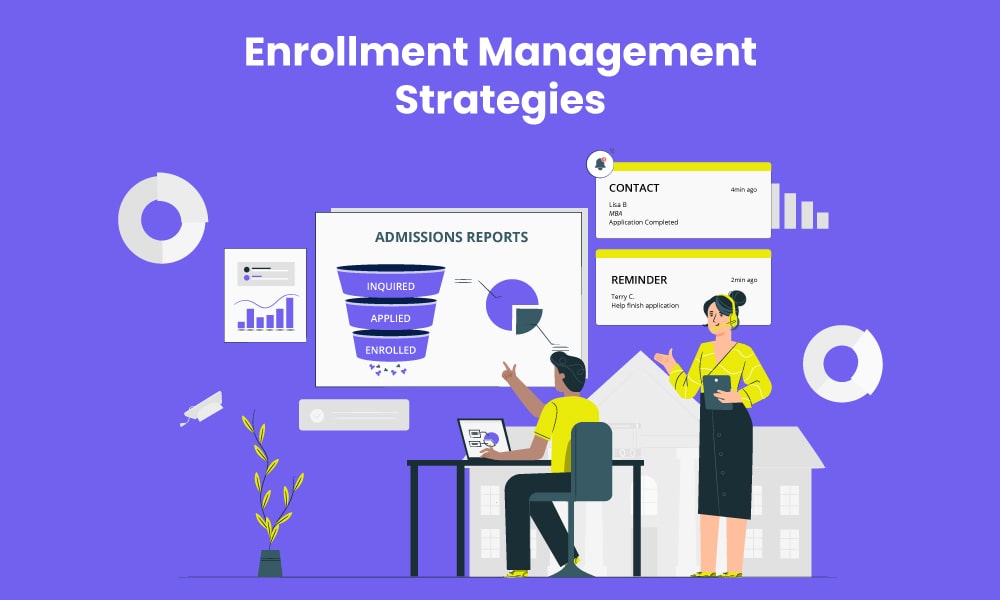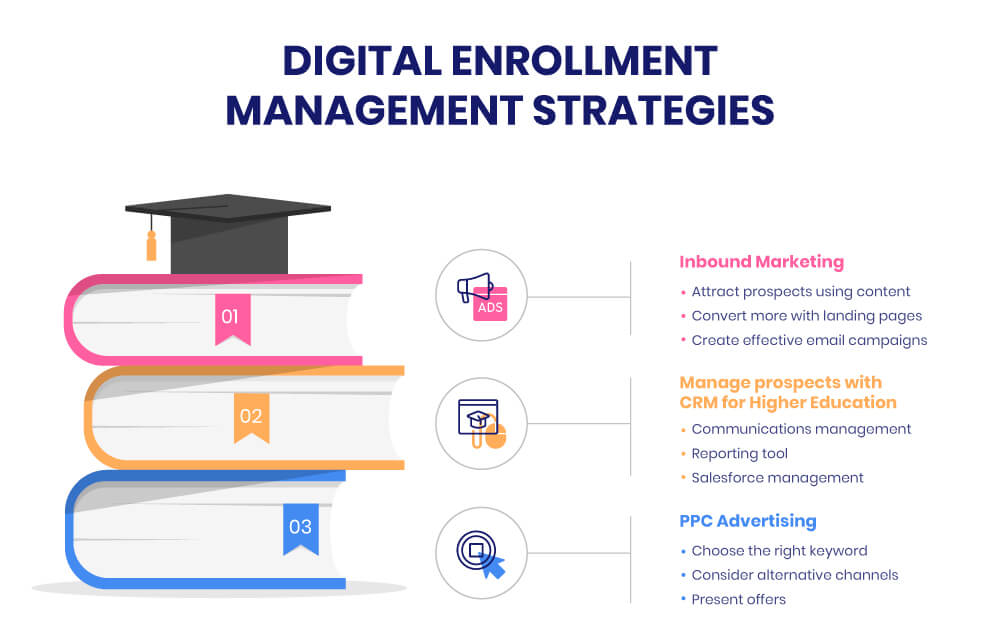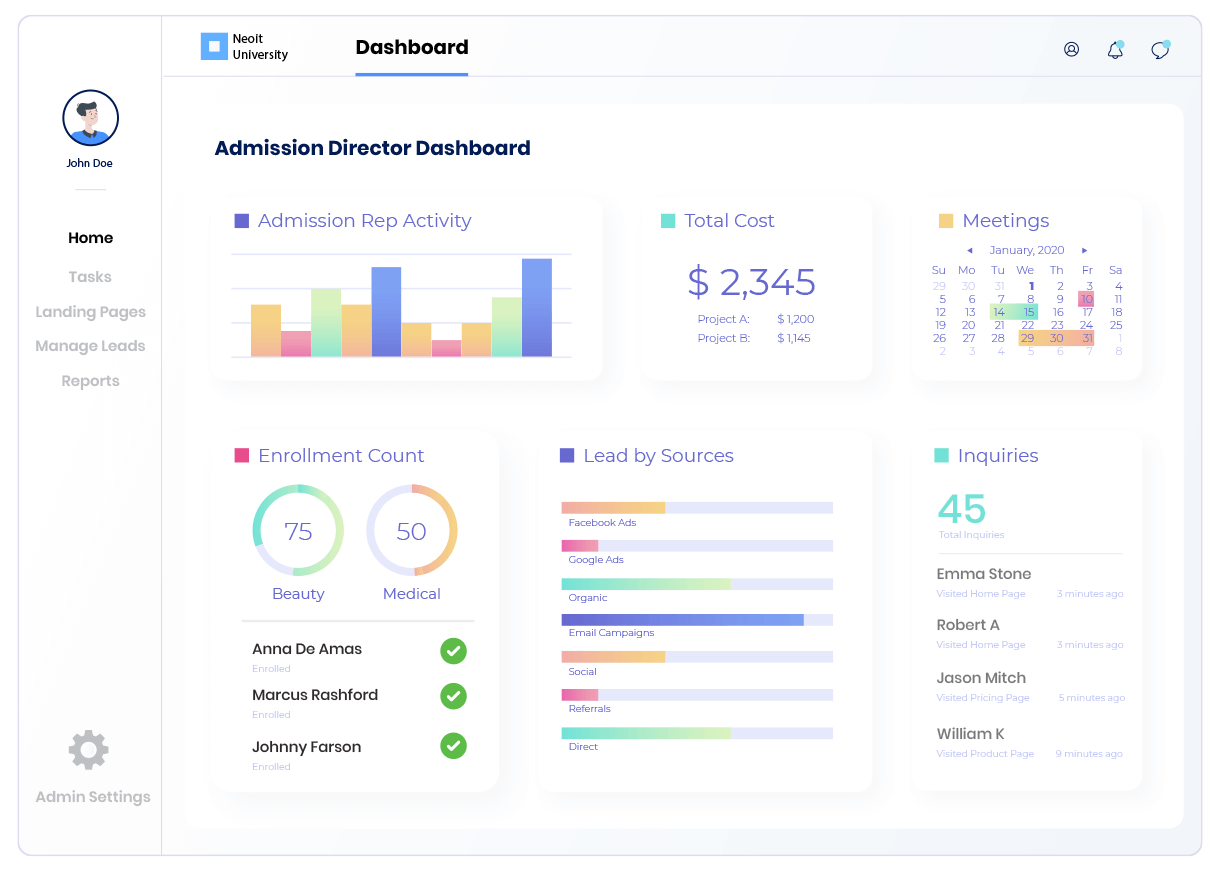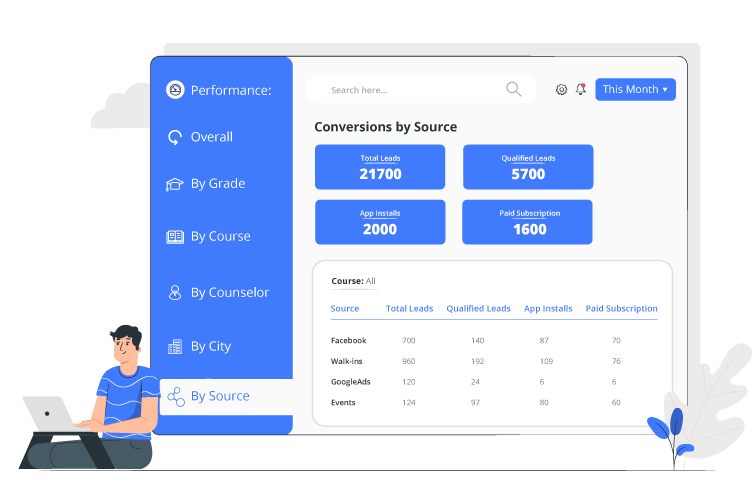
Student enrollment is taking a new dimension due to the coronavirus pandemic. These include the universities and colleges whose enrollment management strategies revolve around international students. Currently, health protocols and lockdown measures have stopped students from traveling.
More and more colleges are moving to online education models. Thus, higher education marketers need to develop new strategic enrollment management plans. In this article, we will share some proven techniques for increasing student enrollment.

1. Pay attention to inbound marketing
The first phase of student enrollment is getting people to show interest in your school. But in a crowded space like higher education, this can be more difficult to pull off. For instance, the United States is home to over 4,000 higher education institutions – signaling a searing competition among higher institutions. Hence, a need for inbound marketing.
Inbound marketing focuses on bringing prospects in by answering their most pressing questions. These are the answers that nudge a prospective student towards choosing your school.
Compared to other traditional marketing techniques, it is more impactful on student acquisition. Need evidence? When picking a school, 19% of students say their primary source of information is online.
Here are some of the best enrollment management strategies for increasing inbound inquiries.
a. Attract prospects using content
Blogging and SEO both play a role in creating awareness about your institution. They also help in attracting the right prospects. But this requires you to have a list of personas. Student persona is the representation of interests, age, demographic, location, and educational background of the ideal candidate.
Personas help you understand the pain points of your prospective students. They help in segregating your target audience to ensure that you are putting effort into nurturing the right candidates. It will also guide you in choosing the right keywords for your SEO and writing the relevant articles, whitepapers, or guides.
Let us assume you own a College of Management. So, you will be interested in students seeking education in management studies. Therefore, you can write an article around the keyword – Top Management Courses in 2020. This way, you will be addressing a learner’s curiosity who is trying to choose a management course.
b. Convert with landing pages
Let us say – you have started to get traffic from your blog posts, guides, or whitepapers. It is, of course, helping in creating awareness about your college. But there is more to it.
You can leverage organic traffic to encourage students to take admission. For instance, you can include call-to-actions (CTAs) into your content. These CTAs will take the visitors to a designated landing page where they can enter their personal information (email, phone number, educational qualification, age, etc.).
But the catch here is in the value of your content and functionality of your landing page. The Higher Education industry already has the lowest conversion rate of 2.6%. Choosing a school is a big decision for anyone hence the hesitation sometimes.
Students will submit their details if your content serves a need. An example is a course brochure outlining the curriculum for the academic session. Such documents offer students a closer peek into their life as a student in your school.

Are you looking for landing page design inspirations for inquiry forms?
Check out this e-book.
c. Create effective email campaigns
The whole point of creating landing pages is to drive leads, which you can use to create a list of prospective students. While this is good news for any marketer, it is still only a list if it is going to be sitting in a folder. Hence, the need for a personalized email campaign.
With their details, you can communicate specific messages about your school. Let us say they downloaded a report on Top Management Courses in 2020. You can send them emails showcasing your current management courses and successful alumni profiles.
The general idea is to create a personalized email workflow that helps to cushion the prospect into applying for one of your programs.
Also read: email marketing best practices.
2. Manage prospects with CRM for Higher Education
As an automated system, a CRM can create a difference for marketing teams. Colleges who adopt CRMs as part of their SEM plan or enrollment management strategies, enjoy a 62% increase in student applications and a 20% reduction in processing time.
With CRM, you can build productive relationships with your prospects even before they walk through the gates of your university. The point is – you need to track the student affairs until they enroll.
It is important because the decision to pick your institution can take days, weeks, or months. The process includes clicking on your blog post, getting emails from the sales team, or asking questions about admission/financial aid.
You can create a smooth enrollment process with a CRM designed specifically for the Education sector. The following are the key features of an Education CRM.
a. Communications management
A CRM for higher education enables you to keep tabs on all communication with prospective students, unlike manual processes where there is no track of drop-off stages.
You can log contact details, phone calls, emails, meeting schedules, and SMS in real-time to deliver automated and personalized messages. Instantly responding to student inquiries fosters their interest in your college and increases the likelihood of the student enrolling in a course.
For instance, Asher College, a leading vocational college and career trade school offering Medical, IT, and Business curriculum having centers in Dallas, Las Vegas, and Sacramento, use the LeadSquared CRM for student engagement and enrollment management.
David Vice, the CEO of Asher College says – “The contact rate went up by 13%, and scheduled campus appointments improved by 5%. Admissions specific workflows helped the admissions team prioritize incoming inquiries, engage with more leads, and identify their passions in a more organized fashion.”

b. Reporting tool
The best decisions are data-driven. CRMs contain all the information you need to make a decision. Many CRM systems also include scoring models that can help you identify which students are most likely to enroll at your school. This way, you can prioritize calling to a student. Moreover, your sales pipeline will only contain qualified prospects. You can also take help of predictive modeling tools to identify if a candidate will enroll into a course or not.
“In the face of the Covid19 Pandemic, we are keeping track of all admission and enrolment activities using LeadSquared reports. Features like clock-in and clock-out and user activity and productivity reports help us get a tight grip on every aspect of our admission process – people, funnel, and revenue.”
Sarah Holmes, Corporate Director of Admissions, Bellus Academy

c. Salesforce management
As a salesperson or an admission team member in higher education, your most important resource is time. You can save a lot of time and speed up student recruitment with CRM.
The best part of cloud-based CRM is – you contact the prospective students from anywhere. That is – you need not always be present on your desk. You can update the student’s profile, assign tasks, offer advice to a prospect on their application, and so on at your convenience.
How to automate the admission process to increase counsellor efficiency? Learn here:
3. Include PPC Advertising in Your Enrollment Management Strategies
Pay-Per-Click (PPC) advertising allows you to target keywords of your choice. It also enables your ads to show above organic search results. It is a tricky one because it involves higher ad spend as compared to organic SEO endeavors.
But, if you have the budget to back it, PPC can generate higher and immediate ROI when done the right way. You can even launch a PPC campaign for high school students. It will create awareness about your college and the courses that you offer. Here are some tactics to help with more success when running a PPC campaign.
Also read: PPC marketing hacks
a. Choose the right keyword
As a business, you must consider the purpose of the PPC campaign. Are you trying to convert prospects into customers or trying to create brand awareness? If the former is the case, you should focus on conversion keywords because they encourage people to take action. On the other hand, generic keywords can drive traffic to your website but will hardly contribute to conversions (admissions).
b. Consider alternative channels
For your PPC campaigns, you can try channels like LinkedIn InMail, especially if you offer graduate programs. LinkedIn is home to this particular group of audience. A lot of people in LinkedIn seek a job and higher education opportunities. But it is advisable to keep the messages personal and to the point to stand out from the crowd.

c. Present offers
Here’s the truth. You need to serve students better. You need to convey the message that you care for the student success. If you can offer discounts on tuition or an incentive that can push leads over the line, you should. For most students, this can be the determining factor when picking an institution. If this is in place, you can include this message in your PPC ads as well.
Wrapping Up: Increase Student Enrollment for your School
You can increase the number of admissions by adopting these enrollment strategies. They can help attract serious candidates and build proper relationships with them. You also get to provide them with the relevant service to make them choose your school.
You can kickstart your journey towards meeting your enrollment goals today. Try out LeadSquared’s automated student enrollment platform.
If recruitment and retention is a concern, then go through these student engagement strategies.
Further reading:
- Using strategic enrollment management (SEM) in higher education to increase admissions
- How to increase enrollment in career schools, community colleges, and Universities?
- Enrollment management best practices
- What is an enrollment management in higher education and why does it matter?
- A guide to student enrollment management system
- 5-step admission strategy for schools to increase student enrollment








